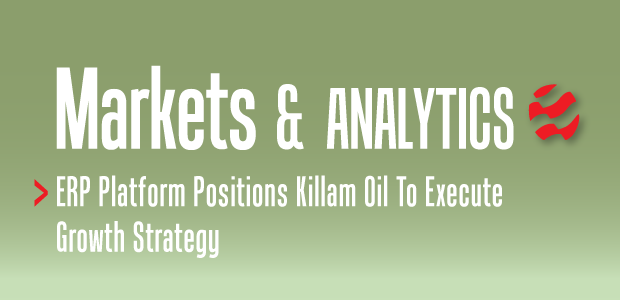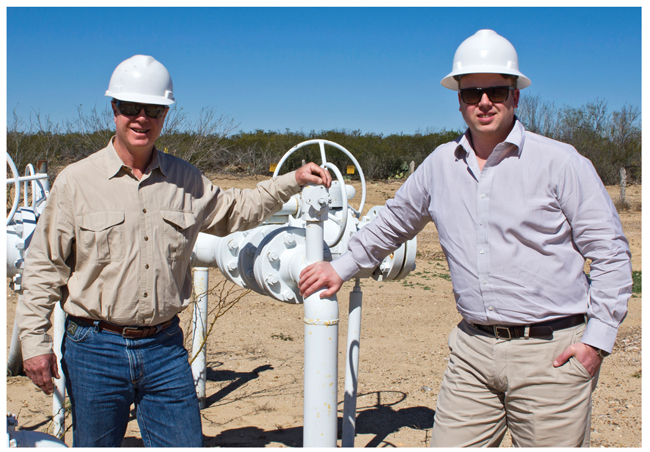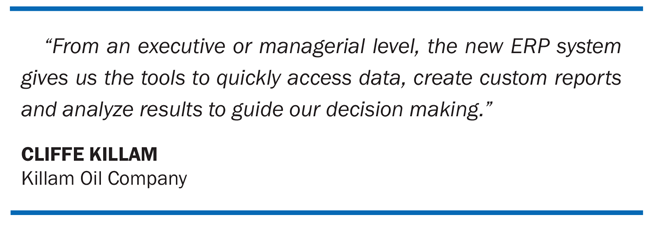
Computing & Analytics
ERP Platform Positions Killam Oil To Execute Growth Strategy
By Tim Beims
LAREDO, TX.–Oil and gas operations generate massive amounts of data every day that must be sorted, stored, processed and analyzed, from permit filings and well logs to production volumes and custody transfer tickets. And the proliferation of digital technologies is bringing a flood of new data types to an industry in which workflows were already heavily data-intensive.
Because of the scale, complexity and multifunctional nature of a routine operation such as drilling a well or managing a producing well, inefficient data processes can breed inefficiencies in operational processes, seemingly small errors or omissions in data entry can lead to costly mistakes, and inadequate or outdated information can result in missed opportunities. Particularly in smaller companies, workflows often include recording and inputting data using manual methods and informal data management practices relevant to a particular department or user group that interacts with the information.
The challenge goes beyond improving the efficiency and accuracy of the data, but also entails better managing it to get the right information to the right people at the right time to glean business intelligence and improve performance. For Killam Oil Company, the solution is to integrate all operational functions and data flow under a cloud-based enterprise resource planning (ERP) framework that unifies every aspect of the business, including land and leasing, drilling and well workovers, production and gathering, accounting and regulatory, and volume balancing and forecasting.
Killam Oil is a private, family-owned business with a “wildcatter” legacy. The family name is synonymous with pioneering the oil and gas business in South Texas, dating back four generations to Oliver Winfield Killam, who came to Laredo in 1919 in search of oil and found it when he drilled the first discovery well in 1921 near Mirando City, a town he founded.
O.W. Killam’s son, Radcliffe, joined his father’s business in 1935 after graduating from Harvard Law School, left to fight in World War II as a U.S. Navy lieutenant commander in the Pacific, and then returned after the war to help lead the business. Radcliffe’s son, David, joined the company in 1975, becoming chief operating officer in 1984 and president in 1992. David’s sons, Cliffe and D.W., represent the fourth generation actively involved in the family business. Like his grandfather, D.W. also served in the U.S. Navy, joining the business as operating manager for the area around Freer, Tx., after serving six years in the Nuclear Propulsion Program.
“There are not many family-owned companies that can say they have been in the oil and gas business for a century,” Cliffe Killam relates. “Today, there are different pillars to our family office: real estate development and acquisitions, investments, and ranching and agriculture, in addition to oil and gas exploration and development. But oil and gas started it all and has remained the focus.”
Capturing Opportunities
The company defines its mission as building profitable oil and gas operations that are sustainable for the long-term while maintaining a rock-solid reputation. The vision is straightforward: become a “world-class oil and gas company that creates world-class opportunities.” Fittingly, the company’s culture is framed by several principles, not least of which are putting family first and functioning as a unified team to find the best way forward.
Shown here are David Killam (left) and Cliffe Killam (right). One of the keys to Killam Oil’s growth strategy is installing a state-of-the art ERP platform to fully leverage its data for up-to-the-minute business insights on the gamut of oil and gas operations, from analyzing the economics of an exploration prospect to evaluating the upside of a potential acquisition deal.
There is no questioning Killam Oil’s reputation and long-standing status as a “partner of choice” in South Texas exploration, drilling and production. It has partnered on projects with some of the biggest names in the business, including ExxonMobil, EOG Resources and Devon Energy. But no matter how strong the balance sheet or disciplined the organization, how does a smaller enterprise find its way forward in such a topsy-turvy market? The answer can be found partly in Killam Oil’s mantra to “implement a learning culture that continually grows and learns to improve profitability, innovate and apply best practices.”
That is where the ERP system comes in, according to Killam. “We spent three years researching ERP software,” he says. “We looked at our existing business and strategy for the future, and spent a lot of time evaluating demos and getting into the details of different applications to understand how the technology could help us meet our existing needs as well as achieve our longer-term goals.”
Those goals can be distilled into a simple statement: capture value-adding opportunities. And Killam says his company sees tremendous possibilities on the horizon for acquiring high-quality assets of all types. “I think we have the opportunity to double, triple or maybe even quadruple the size of the company by acquiring properties,” he enthuses. “We are well positioned to move on a deal quickly and efficiently if we see an opportunity we like.”
Multiplying organizational size and operational scale by a factor of two or more may seem daunting, but Killam Oil has distinct competitive advantages that position it as a ready and able acquirer during a down phase in the commodity cycle that is creating an ultimate buyer’s market.
“Unfortunately, we expect the industry to see more asset sales, rationalizations, restructurings and bankruptcy filings as operators free up capital and refocus their portfolios. That should lead to excellent opportunities in both oil and gas,” Killam suggests. “We are agnostic about whether an opportunity is oil or gas, vertical conventional or horizontal shale, or in South Texas or another basin or state. We are going to be opportunistic and driven by data and economics.”
Gaining Exposure
Historically, Killam’s production has been concentrated in conventional vertical natural gas plays, largely connected to the significant mineral rights position it owns in South Texas, including its 200,000-plus acres of ranch properties. “Our focus has been on conventional gas in South Texas, but like any other oil and gas company, we lease acreage from mineral owners to drill wells and also acquire producing properties,” he notes. “For example, we recently made an acquisition in the Frio-Vicksburg in Starr County, Tx.”
However, the company is active in other areas, namely Kansas and Arkansas, and also has nonoperated interests in the Eagle Ford Shale. According to Killam, its experience collaborating with other producers in the Eagle Ford may be a harbinger of things to come. “Our intention is to gain more exposure to shale plays, including as an operator,” he holds.
Even if the company decides to meaningfully expand its portfolio with unconventional assets, Killam says it will continue to maintain its deep expertise in conventional geology. “We use all the tools associated with traditional vertical exploration and production, including seismic and petrophysics. That won’t change,” he insists.
What will change, however, is augmenting its in-house capabilities with core competencies specific to resource plays. “Shale is a very different world with its own characteristics and challenges, including faster decline rates and parent/child well relationships,” he notes. “For that reason, we expect to add technical talent experienced in shale plays and technologies to our team.”
So, Killam Oil is not only bullish on oil and gas, but it is going all in by seeking to dramatically expand its asset base through acquisitions and add head count to increase the scope of its technical proficiencies. How can a smaller, regionally-focused company play it big in the acquisitions game when so many of its larger peers are being forced to play defense and try get to the next quarter?
“One of our advantages is the autonomy to make decisions quickly. We are not accountable to third-party stakeholders. We don’t have to go to a committee and take a vote before we can act. Only a couple people need be involved,” Killam responds. “We have a strong balance sheet that allows us to acquire assets without being subject to financing. Importantly, we also can be patient and take a long view. That means we may buy assets with near-term challenges, but that offer the upside to be very economic over the longer term.”
But it is not only about recognizing the value of an opportunity; it also is about conducting careful due diligence to scrutinize any potential pitfalls associated with an asset. “From my perspective, there are still a lot of overvalued properties,” he assesses. “But even with a quality asset, it may have onerous marketing contracts or lease terms that are untenable at current commodity prices. There could be a good reason why a quality asset has not already sold or participated in a failed sale. Buyer beware!”
Across-The-Board Upgrade
Given its plans to execute its growth strategy and transform its operations in the months and years to come, Killam says, it became glaringly obvious that the time was right to incorporate an enterprise-level platform as a central unifying link in the value chain. After investigating more than a dozen applications, he reports, the decision was made earlier this year to install W Energy Software’s cloud-based ERP suite.
“Our existing system was at least 20 years old and had a lot of limitations. Data was compartmentalized and difficult to access, and extracting different types of metrics was complicated and time consuming. It was very cumbersome and required lots of manual data entry. Multiple users often had to input the same information again and again, especially in our accounting department,” he recalls. “All of those problems are now eliminated. We have gone from glorified spreadsheets to a state-of-the art system. It is amazing what today’s software is able to do far beyond the basic aspects of running a business.”
As of early November, the system was 60% installed and the company was expecting all the legacy data migration to be complete by mid-December. Once fully in place, he says the software will help Killam Oil acquire and fully leverage data to extract up-to-the-minute business insights, ramp efficiency and productivity, break down departmental silos, and enhance decision making.
“This is a comprehensive, across-the-board upgrade,” he affirms. “Every part of the business is benefitting. It enables us to not only do more with less, but do it faster and better while innovating our processes. There are lot of features we really like, but the fact that the software was built holistically from the ground up specifically for oil and gas was important to us because it aligned with our needs.”
As examples of the functionalities, he points to report generation, automated data entry and system notifications. Through a partnership with IBM’s Cognos web-based business intelligence suite, the W Energy platform provides a user-friendly tool set for reporting, analytics, scorecarding and monitoring events and metrics. “From an executive or managerial level, the new ERP system gives us the tools to quickly access data, create custom reports, and analyze results in ways that help us see the full picture of our operations and guide our decision making,” Killam explains.
Eliminating the need for manual data entry and redundancy also frees personnel to focus on higher-order tasks. “Everyone from pumpers to accounting staff can spend their time on the work that matters, auditing and analyzing numbers, instead of collecting and entering them manually,” he remarks. “Plus, all the data and workflows are integrated under one system with transparency and efficiencies that would be impossible otherwise, so that all departments are always working on the same page.
“If there is an alert from a new well being drilled or a change in production output from an existing well, it automatically communicates that to accounting, financial reporting, land management or any other affected department,” he adds. “Notifications can be customized depending on our own parameters and specifications. That fosters more interdepartmental communication and collaboration.”
Fully Committed
Killam urges other operators that are considering upgrading ERP systems to keep some fundamental suggestions in mind. Chief among them is to explore all available options to find the right fit. But once the decision has been made, it is important to fully commit to the adoption, with a hard-stop target date for installation, he advises.
“Also make sure you get feedback from the entire staff to understand their concerns. Their buy-in is important,” Killam points out. “Be open to asking why things are being done a certain way and if there is a better way. We found that the answer often was, ‘That is just how it has always been done.’ You have to ask those kinds of questions and not be defensive about existing processes. The goal is to enable everyone to do their jobs better and more efficiently.”
Killam’s final piece of advice is to fully leverage the training and service capabilities of the vendor of choice. “Service and training are crucial to the success of any software installation. This is a big change for us, and having excellent service and training shortens the learning curve and helps us master all the features,” he says. “Our staff is excited. They can literally accomplish with the touch of a button what might previously have taken days.”
Not only does the system drive efficiency and save time, but Killam says it presents verified and quality-controlled data in whatever form the user requires at a much more granular level. “I come at everything from a business/financial background, so it allows me to very quickly see cross-sections of information from a financial and operating metric perspective from the company level down to the lease or individual well levels,” he offers.
The ability to quickly examine performance parameters from the macro to micro lets Killam make optimal decisions at business speed, whether considering a workover recommendation on a particular well or evaluating a potential field acquisition. “The bottom line is that with the right technology, we get insights from data much faster, and accelerate the flow of information throughout the business, which in turn, lets us respond faster to not just survive in today’s environment, but find opportunities to thrive,” he summarizes.
For a private company off the beaten path, discovering those opportunities is half the battle of getting in on the deal flow. The company has been headquartered in Laredo since Killam’s great grandfather set up shop 100 years ago, and he says it has no plans to change addresses anytime soon.
“We may be the only oil and gas company in town. As much as we love being here, we are not as connected or as visible as we might be in Dallas or Houston,” he concludes. “We try to overcome that through hard work, building industry relationships, and doing things the right way. The ERP system will help us continue to do that for a long time, and hopefully, help empower us to take the next steps to grow the business.”
For other great articles about exploration, drilling, completions and production, subscribe to The American Oil & Gas Reporter and bookmark www.aogr.com.
















